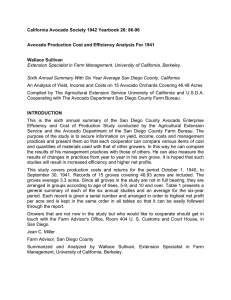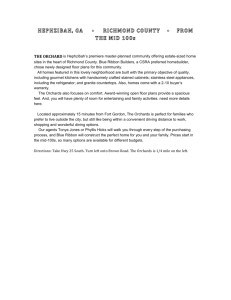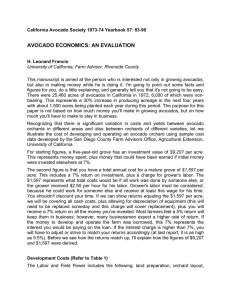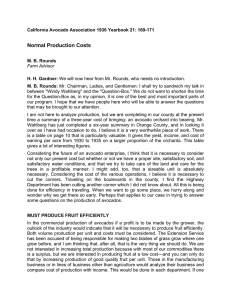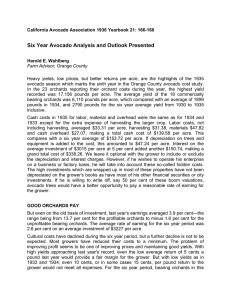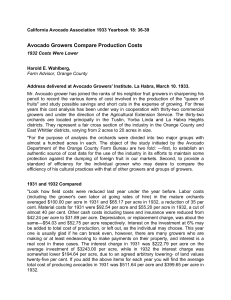Cultural Avocado Cost and Efficiency Study in Orange County for 1931
advertisement
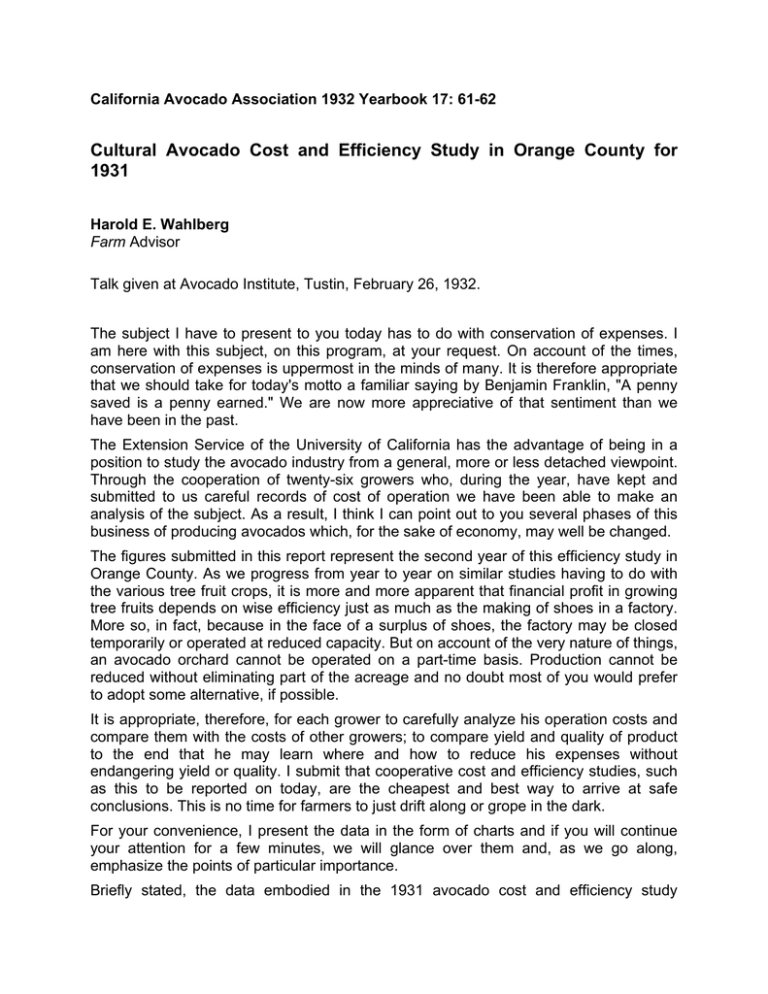
California Avocado Association 1932 Yearbook 17: 61-62 Cultural Avocado Cost and Efficiency Study in Orange County for 1931 Harold E. Wahlberg Farm Advisor Talk given at Avocado Institute, Tustin, February 26, 1932. The subject I have to present to you today has to do with conservation of expenses. I am here with this subject, on this program, at your request. On account of the times, conservation of expenses is uppermost in the minds of many. It is therefore appropriate that we should take for today's motto a familiar saying by Benjamin Franklin, "A penny saved is a penny earned." We are now more appreciative of that sentiment than we have been in the past. The Extension Service of the University of California has the advantage of being in a position to study the avocado industry from a general, more or less detached viewpoint. Through the cooperation of twenty-six growers who, during the year, have kept and submitted to us careful records of cost of operation we have been able to make an analysis of the subject. As a result, I think I can point out to you several phases of this business of producing avocados which, for the sake of economy, may well be changed. The figures submitted in this report represent the second year of this efficiency study in Orange County. As we progress from year to year on similar studies having to do with the various tree fruit crops, it is more and more apparent that financial profit in growing tree fruits depends on wise efficiency just as much as the making of shoes in a factory. More so, in fact, because in the face of a surplus of shoes, the factory may be closed temporarily or operated at reduced capacity. But on account of the very nature of things, an avocado orchard cannot be operated on a part-time basis. Production cannot be reduced without eliminating part of the acreage and no doubt most of you would prefer to adopt some alternative, if possible. It is appropriate, therefore, for each grower to carefully analyze his operation costs and compare them with the costs of other growers; to compare yield and quality of product to the end that he may learn where and how to reduce his expenses without endangering yield or quality. I submit that cooperative cost and efficiency studies, such as this to be reported on today, are the cheapest and best way to arrive at safe conclusions. This is no time for farmers to just drift along or grope in the dark. For your convenience, I present the data in the form of charts and if you will continue your attention for a few minutes, we will glance over them and, as we go along, emphasize the points of particular importance. Briefly stated, the data embodied in the 1931 avocado cost and efficiency study embracing twenty-six Orange County orchards indicate that: Yield: The 1931 crop was a comparatively heavy one. The average yield for bearing orchards was 3995 pounds per acre, as compared with 846 pounds per acre in 1930. The average age of the bearing orchards this year was 7.8 years; the youngest 5; the oldest 14 years. Investment: High investment valuations will require the maximum of efficiency on the part of the grower and orchard to meet the high overhead costs after cultural costs have been paid. The average investment of $3713 per acre bears an overhead charge of $276.82 (interest and depreciation). Cash Costs: Not including interest on investment, the average cost of producing avocados in 1931 was 7.23 cents per pound or $288.85 per acre. The average total cost, including interest on investment, was 12.81 cents per pound, or $511.64 per acre. In order to meet the above cash costs and total costs, the following yields per acre will be necessary at the different prices indicated: Irrigation: Several orchards in this study that had heavier than average yields, used less than the average amount of water. The average amount of water used by bearing orchards was 22.1 acre inches per acre. The average cost of water was $2.70 per acre inch. Avocado trees are sensitive to excessive irrigation. Cultivation: Saving in cultivation costs can be made in some orchards. The net profit orchards averaged $14.22 per acre for cultivation. Some orchards reported from $30 to $80 per acre for cultivation. Fertilization: Manures and simple concentrate nitrogen fertilizers are the materials commonly reported in this study. The average expenditure for fertilizer materials in the bearing orchards was $32.49 per acre. Cost Records: Profit for skill and management offers the greatest opportunity for the grower to increase his personal income. He can do this by keeping accurate records which he may analyze and determine where the excessive costs are and make the necessary cuts or adjustments.
